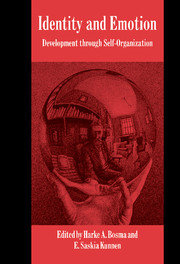Book contents
- Frontmatter
- Contents
- List of contributors
- Preface
- 1 Introduction
- 2 Developments in self-concept theory and research: affect, context, and variability
- Commentary: the self-concept is dead, long live … which construct or process? Differentiation and organization of self-related theories
- 3 The self and emotions
- Commentary: the self and emotions
- 4 Fish, foxes, and talking in the classroom: introducing dynamic systems concepts and approaches
- Commentary: fish, foxes, identity, and emotion
- 5 A relational perspective on the development of self and emotion
- Commentary: the personal experience of coherence
- 6 Affective processes in a multivoiced self
- Commentary: affective processes in a multivoiced self in action
- 7 Old–new answers and new-old questions for personality and emotion: a matter of complexity
- Commentary: emotions as sources of information about the self
- 8 Cognitive–emotional self-organization in personality development and personal identity
- Commentary: two faces of identity
- 9 A self-organizational approach to identity and emotions: an overview and implications
- References
- Author index
- Subject index
- Titles in the series
3 - The self and emotions
Published online by Cambridge University Press: 28 October 2009
- Frontmatter
- Contents
- List of contributors
- Preface
- 1 Introduction
- 2 Developments in self-concept theory and research: affect, context, and variability
- Commentary: the self-concept is dead, long live … which construct or process? Differentiation and organization of self-related theories
- 3 The self and emotions
- Commentary: the self and emotions
- 4 Fish, foxes, and talking in the classroom: introducing dynamic systems concepts and approaches
- Commentary: fish, foxes, identity, and emotion
- 5 A relational perspective on the development of self and emotion
- Commentary: the personal experience of coherence
- 6 Affective processes in a multivoiced self
- Commentary: affective processes in a multivoiced self in action
- 7 Old–new answers and new-old questions for personality and emotion: a matter of complexity
- Commentary: emotions as sources of information about the self
- 8 Cognitive–emotional self-organization in personality development and personal identity
- Commentary: two faces of identity
- 9 A self-organizational approach to identity and emotions: an overview and implications
- References
- Author index
- Subject index
- Titles in the series
Summary
What is the role of the self in emotions? Is it essential for emotions? Emotions are subjective; therefore, what place has subjectivity in emotions, and what place has the subject's representation of this subjectivity? It appears to be legimate to question the extent to which a notion of “self” is indispensable to understanding emotions.
I find it difficult to discuss this issue in a coherent manner. One reason is my lack of familiarity with discussions of “the self.” Another is that the word “self” seems to possess many different meanings that may or may not have much to do with one another. Most certainly, each individual is in some sense a “self,” by definition. But does he or she necessarily “have” a self? For myself, I am not sure. The best way to approach these issues, therefore, seems for me to briefly review my analysis of emotions, and to examine whether and where a notion like “self” appears needed, and in what function.
Such an approach may be useful because by concentrating upon the emotional phenomena one may perhaps steer clear of certain conceptual confusions. The literature on emotional development suffers from them here and there. For instance, it sometimes worries about the age at which a given emotion, say shame (Lewis, 1992), appears. This given emotion is thereby identified by a name that itself is undefined. At what age shame appears is, however, a meaningless question when it is not independently made clear what “shame” refers to, and which of the defining features appear at what age; they usually will not all make their appearance at the same time.
- Type
- Chapter
- Information
- Identity and EmotionDevelopment through Self-Organization, pp. 39 - 57Publisher: Cambridge University PressPrint publication year: 2001
- 12
- Cited by

